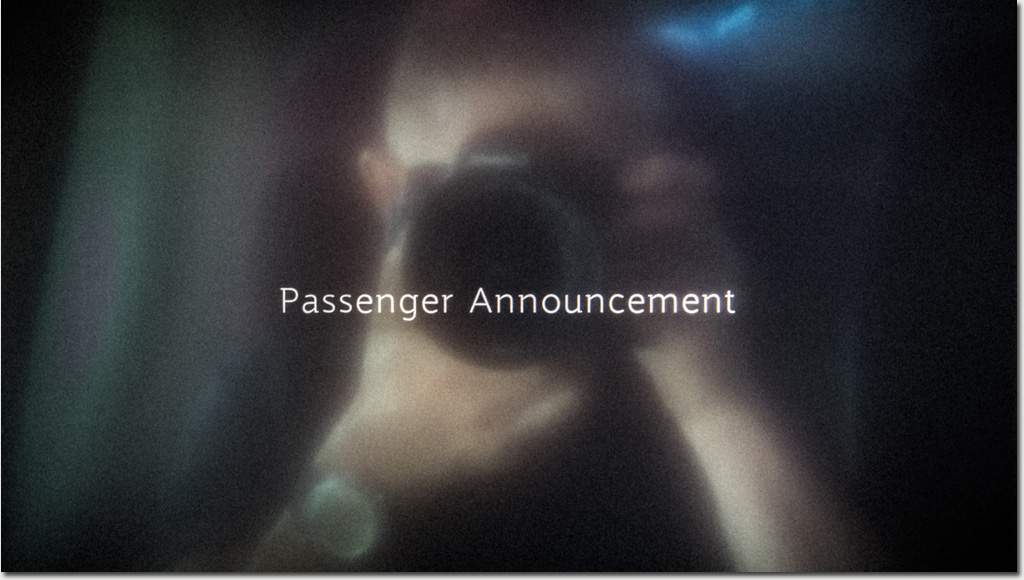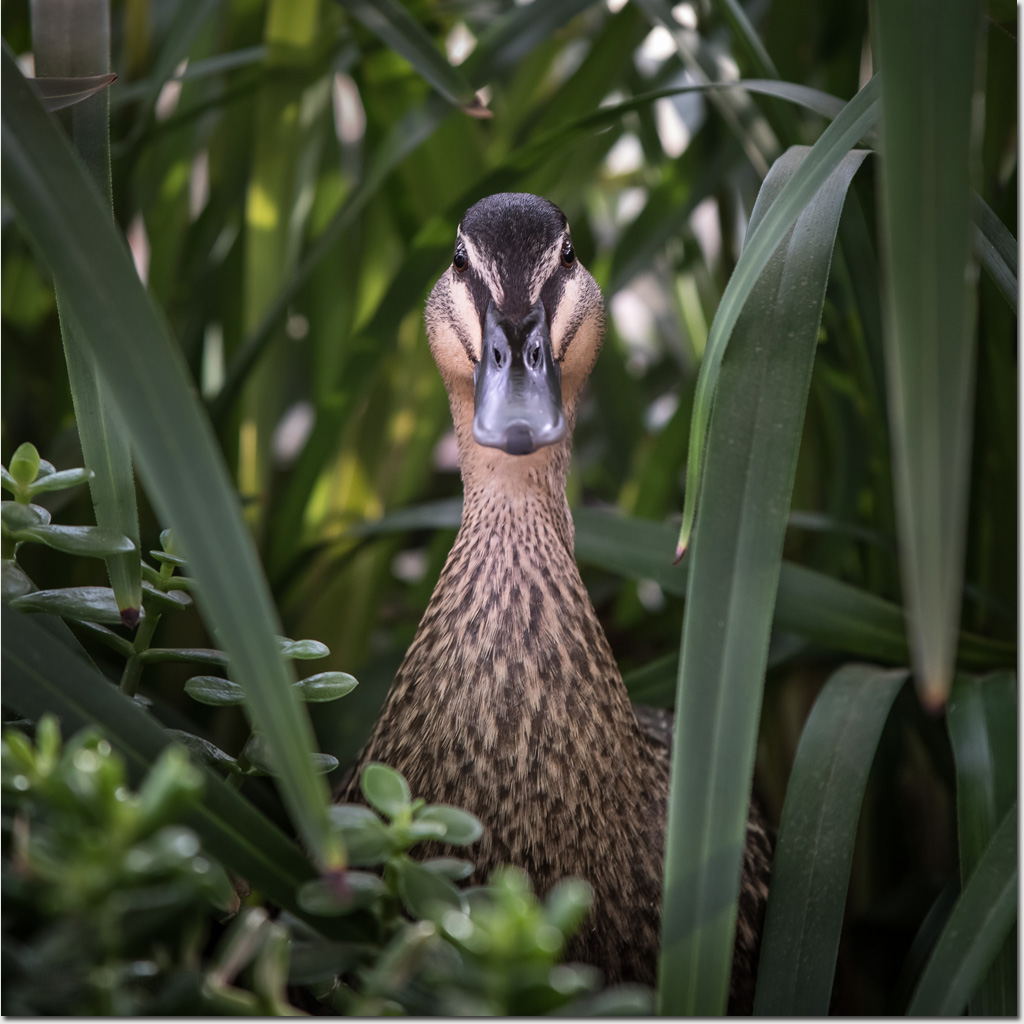Saturday, December 1. 2018
The Brig
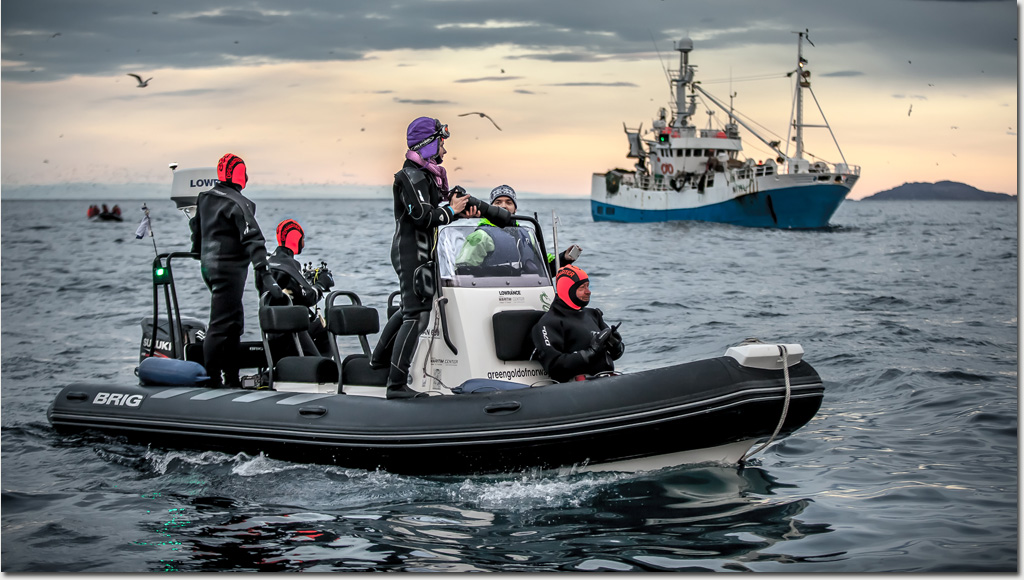
Each day we went out we left the cosy comfort of our host vessel, the Ostee Star, donned several layers of thermal undergarments and enclosed our selves in dry-suits. Two layers of neoprene hoods and gloves later and we were ready. I added another twelve kilograms of lead on my weight belt just to male sure I'd stay under the water with all that undesired buoyancy.
We spent our days out in the fjords on the fast and nimble inflatable runabouts, 'Brig' and 'Nemo'. These small but quick boats were essential to moving us around quickly as we followed moving pods of orca or traveled to flocking seabirds hinting at an orca hunt in progress off in the distance.
These little boats and their drivers, Norbi here on the Brig and Ali on our boat Nemo, not only gave us a sense of freedom out on water but also of vulnerability, excitement, and adventure. The other advantage of these stable little boats is being able to get into the water and back onto the boat quickly again. I lost count of how many times Ali called "into the water' and then "back in the boat", over and over and over and over.
Of course we did not have to get into the water for every orca encounter. There was plenty to see from the boats as well. Sometimes not jumping in was the better option as many of our underwater encounters were just brief glimpse when the pod choose to dive below us or change direction.
Most of the peopIe I know think of an adventure like this one with the orca in Norway as being a 'once in a life time' experience. I'd like to turn that around into 'a lifetime of' experiences. I'll be back!
Photo: Robert Rath, 'The Brig', 1/800s f/2.8 ISO640 70mm
Thursday, November 29. 2018
Paying Attention
Tuesday, November 27. 2018
Beauty Below Me
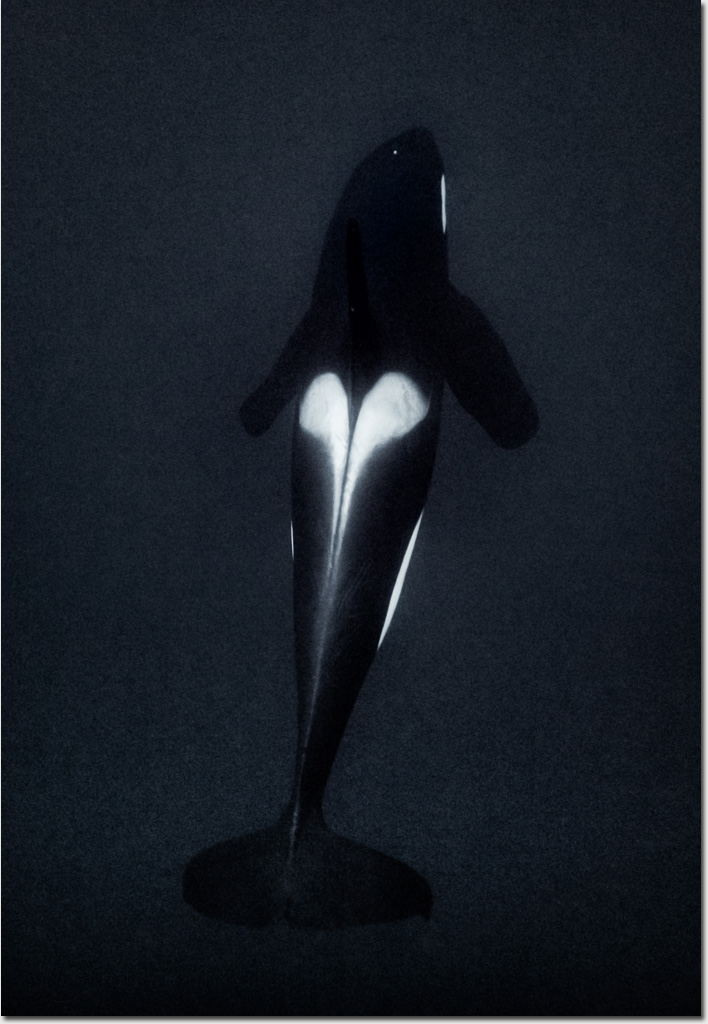
Most times we entered the water with these beautiful animals they would simply dive down leaving us with a just tantalising glimpse as they disappeared into the depths.
Even when they stayed close to us for a while out of curiosity the low light and the poor visibility meant that our human eyes were much better suited to simply watching than looking through a viewfinder.
As I gave my attention to this large male cruising beneath me, ten others of the pod cruised right by me to my chagrin and the delight of the others. I did however get to see them for just a moment before they also disappeared into the distance.
Still I am in awe of this particular moment when I was so close that I could have reached out and touched his fin.
Photo: Robert Rath, 'Beauty Below Me', 1/160s f/2.8 ISO8000 31mm
Monday, November 26. 2018
Capturing The Wonderful
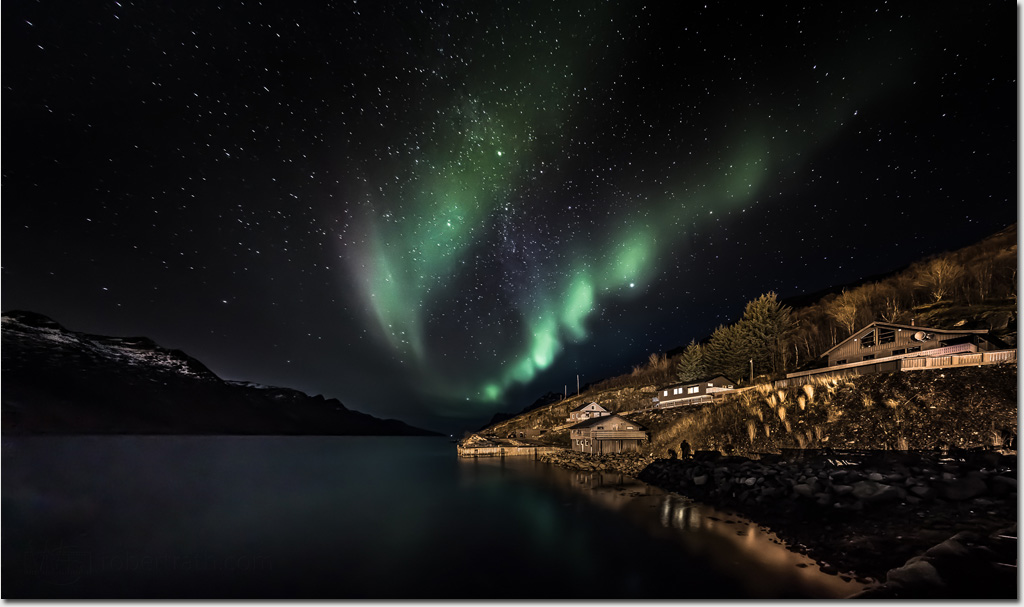
I had just arrived in Tromsø, made the short trip to Ersfjordbotn and began getting settled on board our vessel when the word went out, 'the lights are in the sky'.
Half unpacked, find tripod, check camera, leap from the ship onto the wharf, find a spot, set-up and go! What a wonderful introduction to Northern Norway!
This very first glimpse of the aurora borealis has a special place now in my heart. Like the very first time I remember seeing snow, or even the ocean.
This wonderful moment shared by all of us, still strangers on our first day, set the stage for the friendships we would make.
I don't know who from our little group is in the middle field, crouched alongside their own tripods. I do know that they where just as taken with capturing this wonderful sight as I was.
Photo: Robert Rath, 'Capturing The Wonderful',30s f/4 ISO1600 13mm
Saturday, November 24. 2018
Norwegian Gold
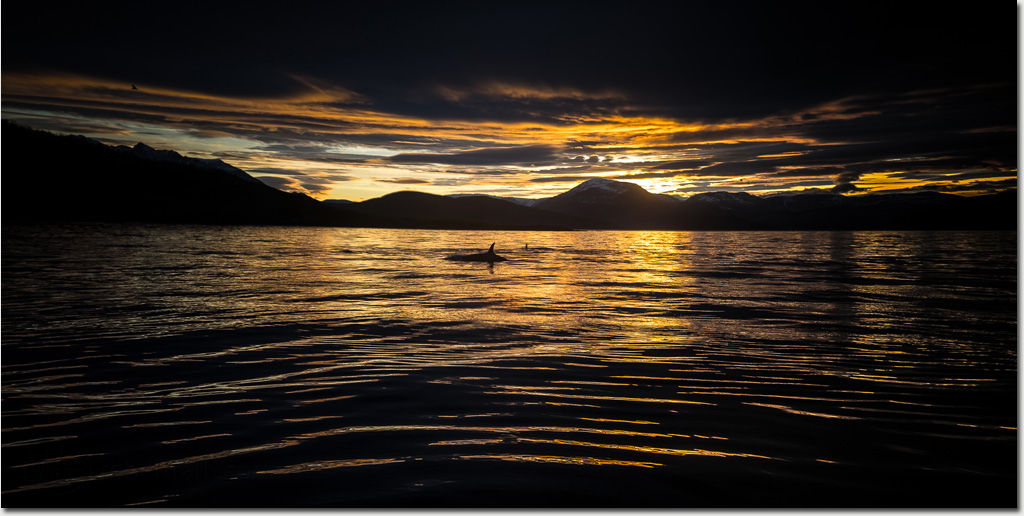
Nothing could have prepared me for my time in Norway.
Even while I was there the immensity of the collective experiences seemed to elude me amid the extraordinary moments, the waiting between them and even the, albeit very brief, miserable ones.
With more than thirty hours of travel on my own from Adelaide to Tromsø I had plenty of time to worry if this experience was going to be everything I imagined it to be. I was worried I would not be fit enough for my time out on the water. I was worried my equipment would not be good enough. I was worried we would not find orca and I was worried I'd come home with an experience somewhat less than the one I imagined. Oh how I worried in vain as nothing could have prepared me for the amazing days which followed.
When I arrived in Tromsø I had the warmest welcome from old friends Darren, Jasmine, Pasi and Ali and began meeting the rest of the team for our arctic adventure. That evening Norway welcomed us all with an extraordinary light show of emerald green veils dancing across the night sky. Not once in my planning had I even anticipated seeing this wonder of the arctic which took away the chill of the icy wind as we all reveled in its beauty.
The next day in Skjervøy we found orca, hundreds of orca and tens of humpback whales. It was like nothing I imagined. This was their home for the winter and I felt so privileged and humbled being here with them in such a beautiful place.
Over the days which which followed we had countless incredible moments swimming with orca and swimming with the humpback whales. We floated over undersea rivers of Norwegian herring come here to spawn. In the evenings we shared our stories from each day. We learned about orcas around the world and their behaviors both in the wild and in captivity. We worked on and shared our images. We reveled in the northern lights on the clear nights and we slept soundly after very physical days out on the water. And, we made new friends.
Over eight days together on the boat Ostee Star I got to know Peggy and Torben, who fed us and kept the boat running smoothly and Krisztina and Norbi who taught us about the orca and guided us out on the water. My old friend Pasi made the perfect cabin companion being tolerant to my late nights. I made new friends with Chuta with his infectious laughter, Sonya and her gentle way, with Carra and her photographic enthusiasm, Elvira and her quiet nature and with Kei and his generosity. I can honestly say that by the end of the trip I loved being with every one of these beautiful people and was sad saying goodbye to them as much as to Norway when it was time to come home.
I need to especially thank Darren and Jasmine who created and ran this tour. You guys are amazing having put together an experience I will forever cherish. Thank you both. Last but not least, thank you Ali for keeping us safe out on the water and dropping us into the ocean for those amazing whale experiences.
This trip has been a treasure of experiences I never imaged and will never forget. I am both humbled and grateful such and extraordinary opportunity has come my way. Thank you to every one of you who helped create this experience of a lifetime.
Photo: Robert Rath, 'Norwegian Gold ',1/400s f/2.8 ISO125 35mm
Tuesday, November 20. 2018
Noonday Bokeh
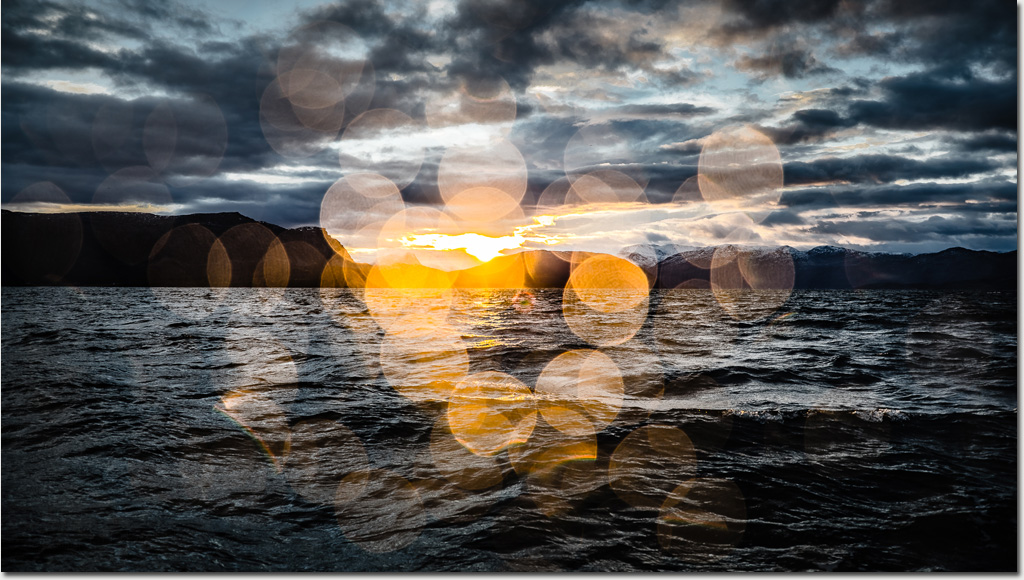
It's high noon and the sun has gifted us a rare glimpse of itself between the distant peaks.
We have been lucky while in Northern Norway with mild albeit cold conditions. The sunshine has however been elusive and in just one week from when this image was captured the sun will no longer grace the visible horizon remaining hidden behind the mountains. One week on from then and the sun will not rise again until mid January.
I wonder what it would like to live here for a year? Would the long summer days be a comfort after the dark winter? What would it be like in summer when the sun never sets but spins around and around in perpetual circles like a yellow searchlight.
I am sure I will be back here again one day, though perhaps not for a year.
Photo: Robert Rath, 'Noonday Bokeh ',1/320s f/2.8 ISO100 31mm
Dream Boat
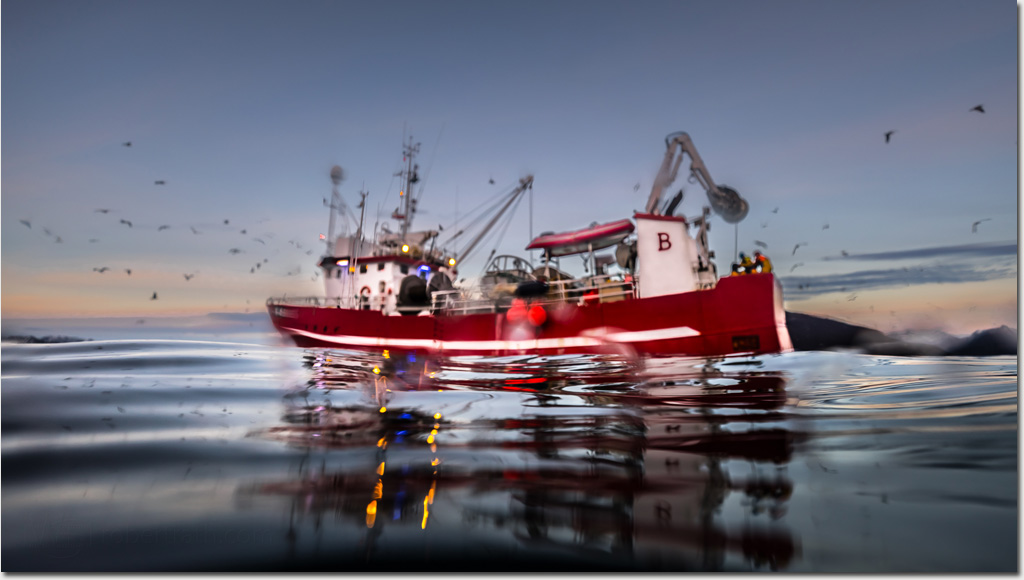
Floating here seams so surreal. A contradiction of serene calm and the frantic busyness of a fishing vessel eager to depart with the spoils of their morning's work.
Just moments before the sea was alive with gulls in the air, with orca stealing from the nets and with humpback whales cruising, waiting for a catch to be dumped if the fishers experienced problems hauling in.
Like in a dream I ponder the unlikeliness of finding myself here in the extraordinary place.
Photo: Robert Rath, 'Dream Boat',1/160s f/2.8 ISO100 16mm
Monday, November 19. 2018
Aurora Borealis
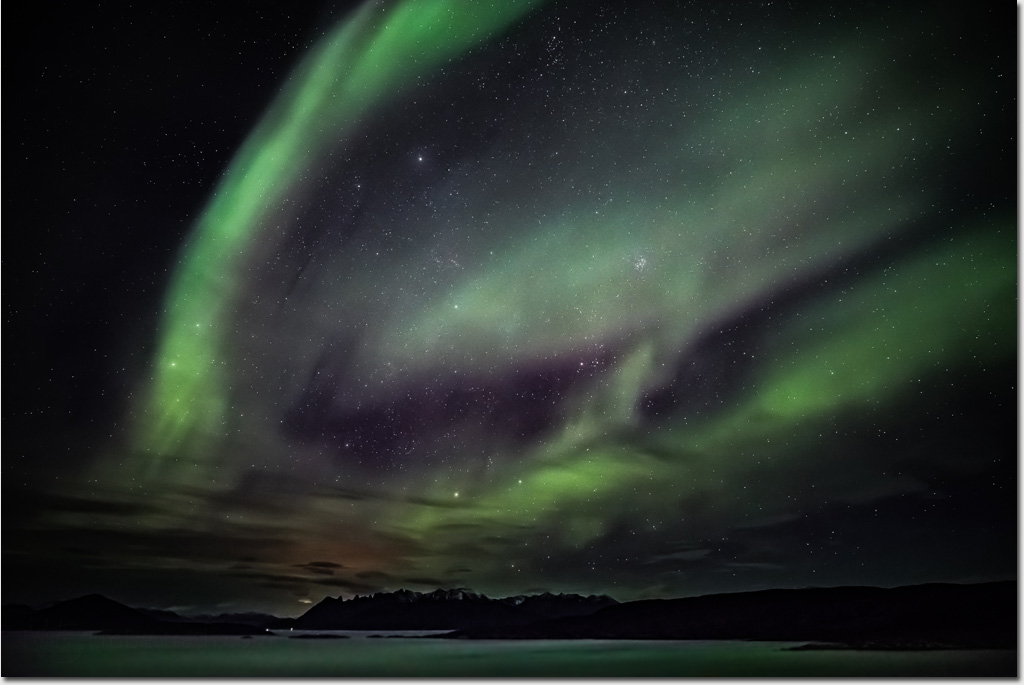
The Auroras have been a mystery to me my entire life, something almost never seen from southern Australia and certainly not by me.
I had seen photographs, watched documentaries, even studied a little on how they are formed. Still they had remained to me in the world of myth. My visit to Norway changed everything.
My very first encounter was in the night sky of Tromsø. At first I thought I was looking at wisps of cloud in the sky as if lit by city lights below. Then I noticed that hallmark green glow.
The next night up in Skjervøy, 386 km above the arctic circle, the night sky simply took my breath away.
We watched those coloured veils of light dance across the entire sky from snow capped peaks to snow capped peaks while the calm waters of the fjords glowed green below.
The Auroras truly deserve there mythical place in our imagination and not for me they are real.
Photo: Robert Rath, 'Aurora Borealis',10s f/4 ISO3200 16mm
Sunday, November 18. 2018
72 Beers

Ølhallen in Tromsø may be the oldest pub in the Arctic but at ninety years it is certainly Tromsø's oldest.
I am sure they did not start out with 72 beers on tap but 90 years later that long bar with all those beers is an impressive sight. Just watching the barman pour our tasting selection was almost as much fun as drinking them.
We tried a selection of Norwegian beers ranging in strength from mild to very strong. All were wonderfully refreshing though perhaps after having spent a week on the ocean we were a little unbiased!
Photo: Robert Rath, '72 Beers', 1/50s f/2.8 ISO2500 110mm
Saturday, November 17. 2018
Beauty in the Gloom
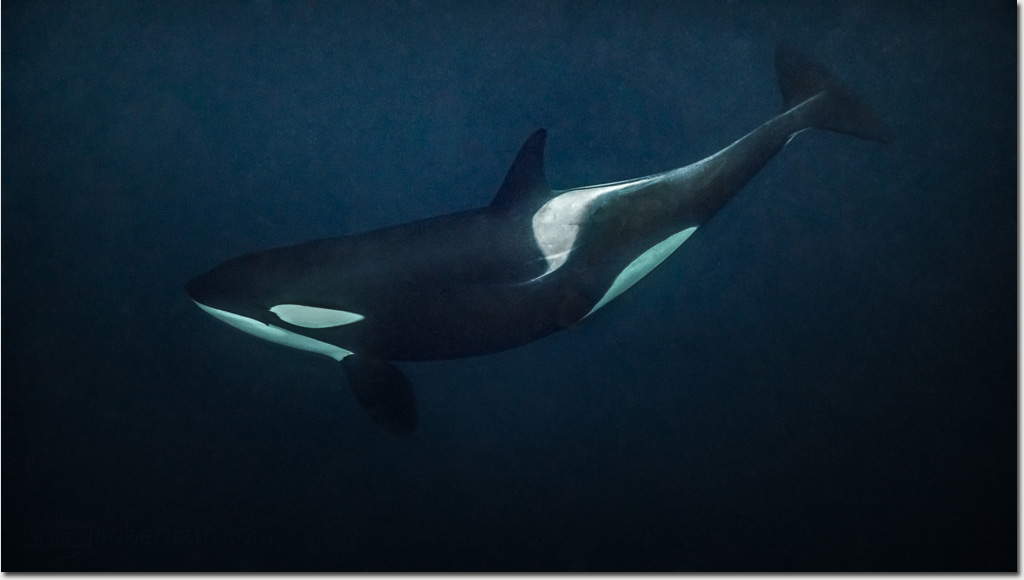
The classic orca images we see in posters of large dorsal finned animals cruising in pods through misty fjords are almost a clichéd view of the majesty of the orca. They are however just a surface glimpse, the tip of the orca, of their amazing lives below the surface.
Here in Skjervøy in November there is very little light, the visibility underwater not so great and the orca are often swimming very fast. Little surprise most images are captured at the surface. To capture this image underwater I am having to shoot around ISO 5000 with a wide open f/2.8 aperture and pan with a fast shutter speed.
After multiple frustrating attempts over days at composition, focus, timing and just waiting it soon became obvious in these gloomy conditions that our eyes and our hearts are a far better tools than my camera will ever be. In the dim light and often at the limit of visibility we have been able to observe, appreciate, sometimes even laugh at, and hopefully learn a little more about the orca as they hunt and play and socialise and be themselves.
I can't possibly capture how breathtakingly beautiful the orca are underwater. That challenge extends far beyond just the gloom and the visibility to their extraordinary presence, power and grace. I am however grateful to be given the opportunity to try and will be back for certain.
Photo: Robert Rath, 'Beauty in the Gloom', 1/160s f/2.8 ISO5000 35mm
Friday, November 16. 2018
Norwegian Wonderland

There are no words describe the world which has greeted us every morning here in the fjords of Skjervøy, Norway. It presses all of my buttons on what makes our world beautiful.
Snow capped mountains, forests, an extraordinary sunrise, dramatic clouds and the ocean all in one amazing and integrated earthscape. This really is a very special part of the world and I know how privileged I am to be here.
The fact that the orca and humpback whales inhabit these beautiful waters as well make being here a humbling experience which I am so grateful to have the chance to experience.
Photo: Robert Rath, 'Norwegian Wonderland', 1/1000s f/2.8 ISO640 70mm
Thursday, November 15. 2018
It's All About The Fish
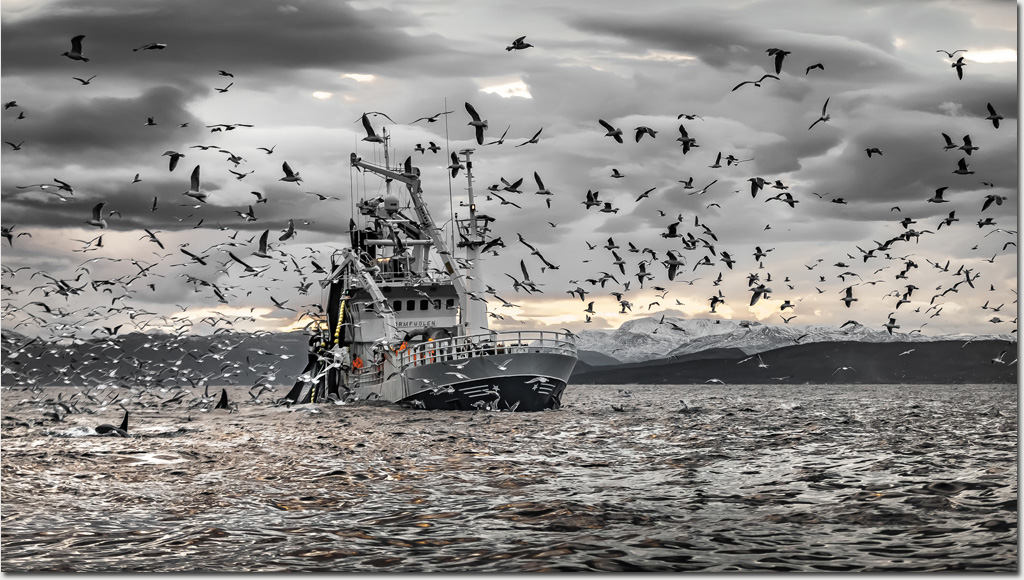
When we arrived in Skjervøy we realised for certain that it's all about the fish and not the orca.
This little Norwegian town with it's spectacular backdrop of snow capped peaks is all about fishing. When we arrived in port we were struck with the scale of the fishing support infrastructure for such a tiny place.
On the wharves were cranes so large they'd be at home on a multistory construction site. Here they were being uses to haul fish and fishing nets from the boats.
As for the orca, those beautiful creatures I came half way around the world to swim with, you can see a few here in this image frustrating the fishermen as they haul in their nets. Usually the orca will circle the nets pulling herring through the netting one by one. A riskier but more productive tactic is to jump into the net, not to eat the herring, but to force the fishermen to release the net and releasing all the captured herring to the attendant orca, humpback whales and seagulls,
So it's always been all about the fish here in Skjervøy and the orca, though a nuisance to the fishers are a boon for us
Photo: Robert Rath, 'It's All About The Fish', 1/1600s f/2.8 ISO640 70mm
Wednesday, November 14. 2018
Breakfast Gatecrashers
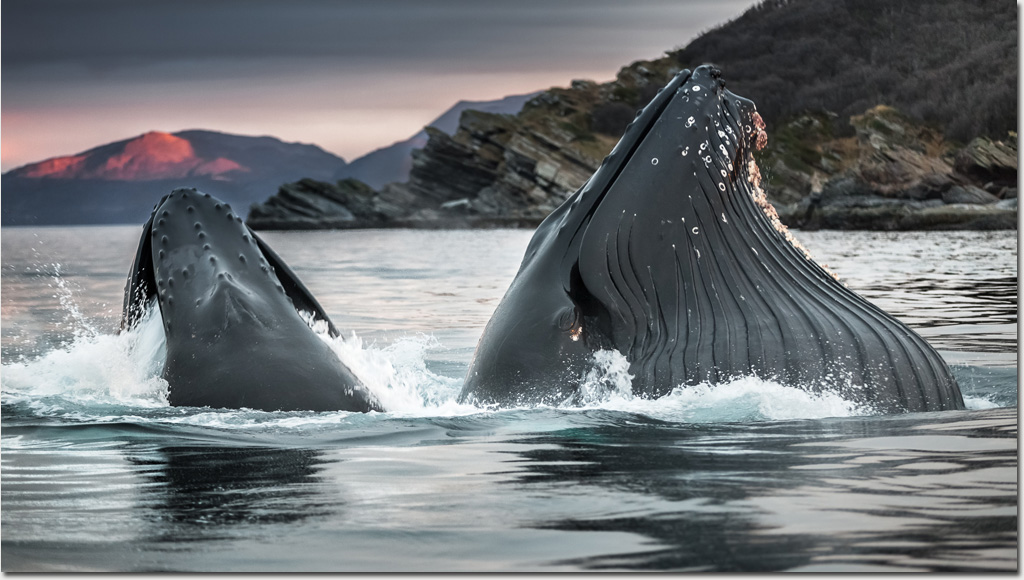
Out before sunrise we headed east then south from Skjervøy in search of orca and hopefully to observe their hunting prowess on the migrating herring.
The orca hunt herring by corralling them into a tighter and tighter swimming mass until the herring school forms a dense ball that the orca force to the surface. At the surface the orca will take turns to charge the school and perform a tail slap stunning the herring and making them easier to catch. This is the behavior we were hoping to photograph.
In the distance we could see the sea birds circling, a sure sign of underwater activity. As we made our way we spotted our first orca also heading in the same direction, ... also a good sign that there is something going on. We also passed a couple of humpback whales, who clearly had gotten the same invite, heading again towards the birds!
When we arrived it was clear that there were orca beneath us and busy doing something. Then we noticed the bubbles rising to the surface from some unseen boiling cauldron. "Quick, get ready", Ali called. Some orca broke the surface while others continued below and then suddenly the ocean went quiet.
Without warning two enormous humpback whales suddenly emerged from the centre of the bubbles with mouths agape reaching nearly three meters into the air. Their mouths closed in on what must have been a tonne of herring and seawater. There was a brief pause at the surface to allow the seawater to drain through their sieve-like baleen before they slipped quietly away beneath us. The herring never stood a chance.
"There goes our bait-ball', Ali sighed, as the orca who had worked so hard abandoned their gatecrashed breakfast in search of a meal elsewhere.
This kind of behavior happens often as the humpback are attracted to the sound of the orca at work who need to work quickly to ensure they get to eat first. In general the orca accept this when the herring is in abundance but in leaner locations or times that tolerance runs low and the orca will actively chase away any potential breakfast gatecrashers.
Photo: Robert Rath, 'Breakfast Gatecrashers', 1/125s f/2.8 ISO1600 135mm
Tuesday, November 13. 2018
Leader of the Pod
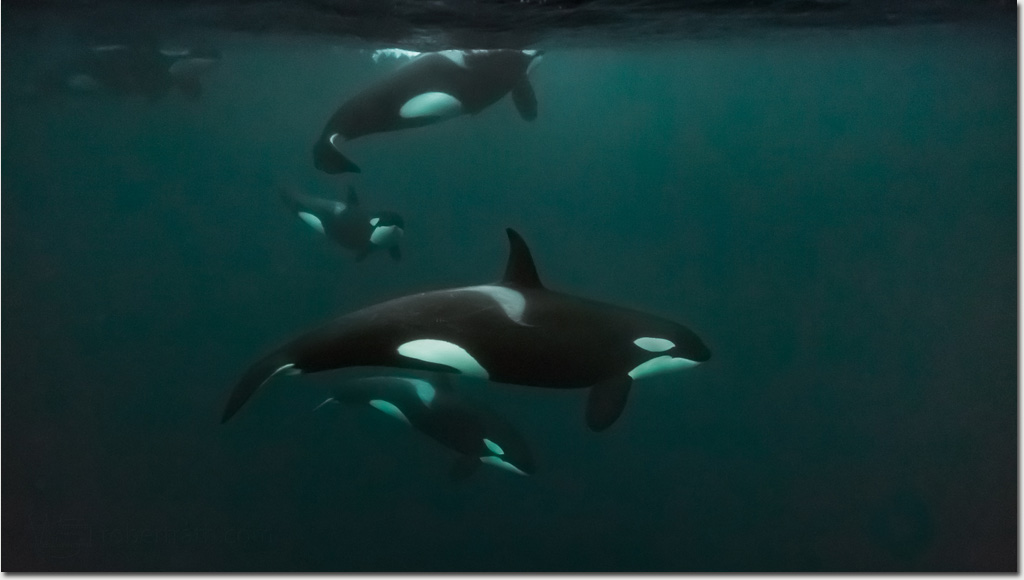
Being in the water with orcas in the seven degC fjords around Skjervøy, Norway is unlike any other photographic environment I have ever found myself in.
Simply getting in and out of our boat in restrictive dry suits, heavy weight belts and then working with heavy cameras is taking its toll leaving me wishing I was significantly fitter than I thought I was. Still though, to quote my high school math teacher, "effort brings reward", this is one of the most rewarding experiences of my life and worth every effort needed.
All our encounters so far have been brief but we are starting to understand a little about the behaviors of orca who are amazingly social creatures that rely on strong family bonds and strategic co-operation to survive.
The leader of the Pod is the matriarch who will raise her calves, train them, discipline them and maintain the family cohesion of her pod. The larger males with their impressive vertical dorsal fin fulfill their role in strategic hunting and in visiting other pods to provide a genetically distant breeding male then returning back to their own family pod again.
This brief encounter in the dim evening light shows a large female in the foreground, probably the matriarch, two other females mid water, while the two at the surface are likely to be males. This is a very typical orca family unit here.
I am so looking forward to getting back in the water with these beautiful creatures and the required effort will only make me stronger.
Photo: Robert Rath, 'Leader of the Pod', 1/320s f/2.8 ISO10000 16mm
Monday, November 12. 2018
Apex Predator
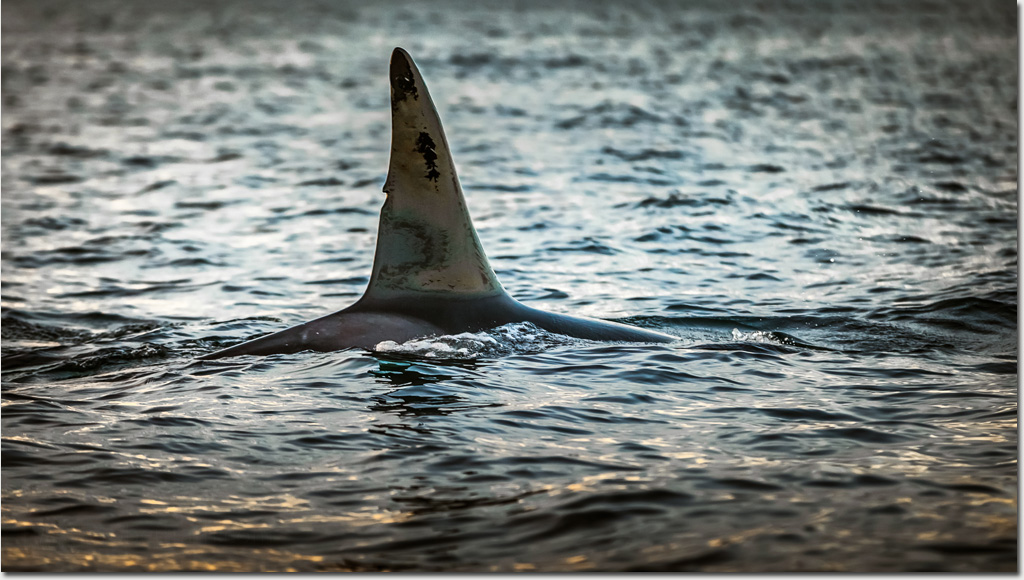
Orcas are an apex predator meaning that in their ecosystem they are at the very top of the food chain. Even great whites live in fear of these gorgeous but deadly animals.
That being said they are very vulnerable to the very ecosystems they reign, potentially succumbing to stored toxins brought up through the food chain or even the loss of their food supply could spell the end of a specialised subspecies.
In in the food rich waters waters of the Norwegian fjords these resident orcas only eat the herring migrating from the North sea's arctic winter. Other fish species, sea mammals, sea birds and even underwater photographers can swim along side the orcas in safety, ... that is unless we take all the herring then who knows.
Photo: Robert Rath, 'Apex Predator', 1/1000s f/3.5 ISO800 200mm
Sunday, November 11. 2018
Mother and Child
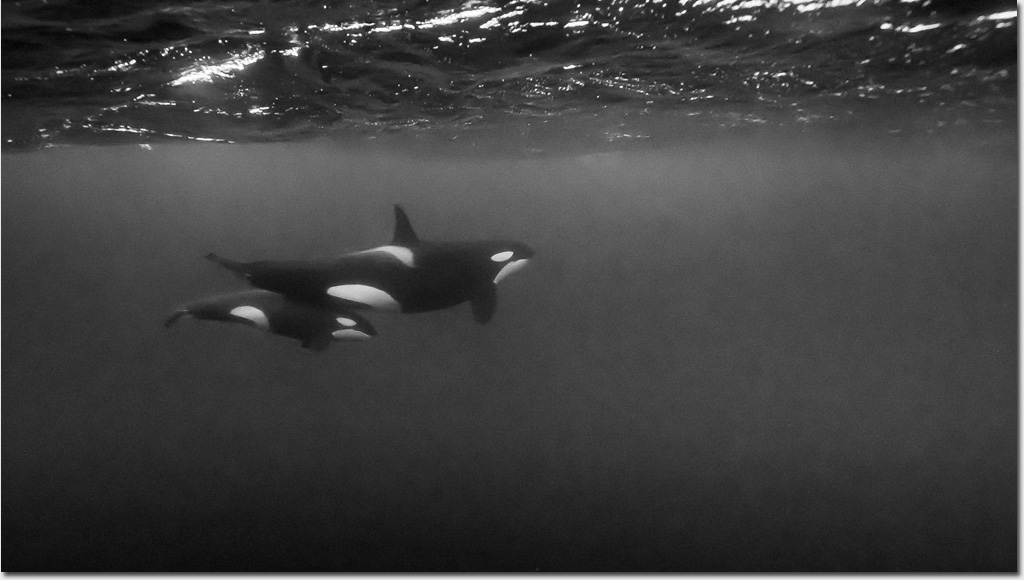
Just imagine for a moment the arctic waters of Skjervoy, Norway, with orcas and humpback whales amid massive schools of herring all migrated here for winter.
Now imagine jumping into that freezing water and swimming with them!
It's an incredulous path that has led me here to swim with and photograph these beautiful creatures. I feel both privileged and grateful that I find my self in one of the most beautiful places on Earth with these amazing and intelligent creatures.
This adventure has only just begun.
Photo: Robert Rath, 'Mother and Child', 1/200s f/6.3 ISO12800 16mm
Saturday, November 10. 2018
Norwegian Tiger Eye
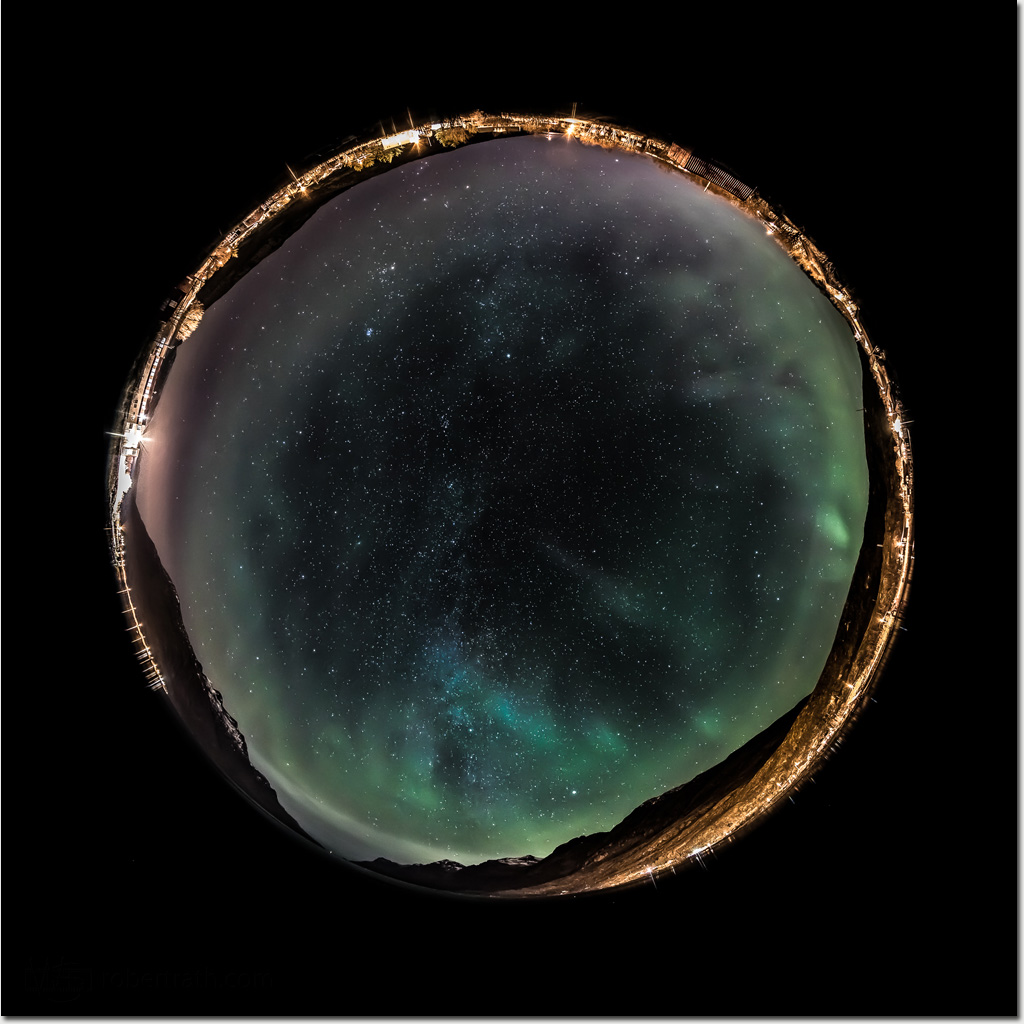
After 32 hours of travel, catching up with old friends, making new ones and settling into our home together for the coming week at sea, this is the night sky we were greeted by.
Amid the deep fjords of Tromsø, a little group of us have come together to explore the waters to the North searching for and hopefully to swim with orca and humpback whales under the the Northern Lights of arctic Norway.
Photo: Robert Rath, 'Norwegian Tiger Eye', 30s f/4 ISO1600 8mm
Tuesday, November 6. 2018
It Never Rains Underwater

It's funny how I react to the rain when dressed top to toe in a neoprene wet suit.
An umbrella makes it seem like there is no rain at all. A raincoat creates a cozy cocoon around dry clothes within. To not leave the house at all is either being slave to the weather and all its machinations or giving it the one finger salute. Being in a wet suit however is different altogether.
I know I am about to climb into a very wet ocean and, once underwater, who cares if it's raining. Still, standing here in the rain, getting wet in my wet suit seems odd to the point of incredulity. ... Much better to get out of the rain and under the water!
Photo: Robert Rath, 'It Never Rains Underwater', 1/50s f/11 ISO2500 16mm
Monday, November 5. 2018
ApocalypseDive
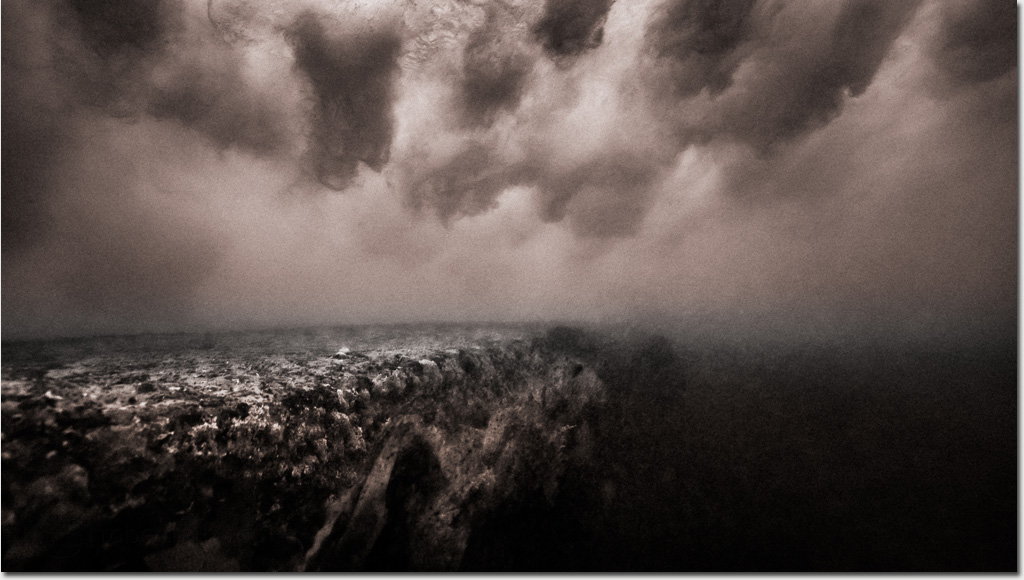
Not more than five minutes into Sunday night's dive I was thinking that it was a really bad idea going diving on dusk with no lighting and a high tide bringing rough seas pounding over the reef filling the water with vision sapping debris.
Still this was a shakedown dive and the principle objective was to practice photography in extremely poor lighting conditions. It seems I got my wish.
What you don't get to see in this barren reef bashed image is just how prolific the fish life becomes on Port Noarlunga Reef when the conditions are rough. Aside from the usual suspects there where schools of trevally, yellow-fin whiting, cruising Port Jackson sharks, bulls-eyes and herring cale. I could even hear dolphin chatter amid the crashing ocean soundscape.
Not much fun for photography but a thoroughly enjoyable dive!
Photo: Robert Rath, 'Apocalypse Dive', 1/250s f/4.5 ISO2500 16mm
Sunday, November 4. 2018
Suspended
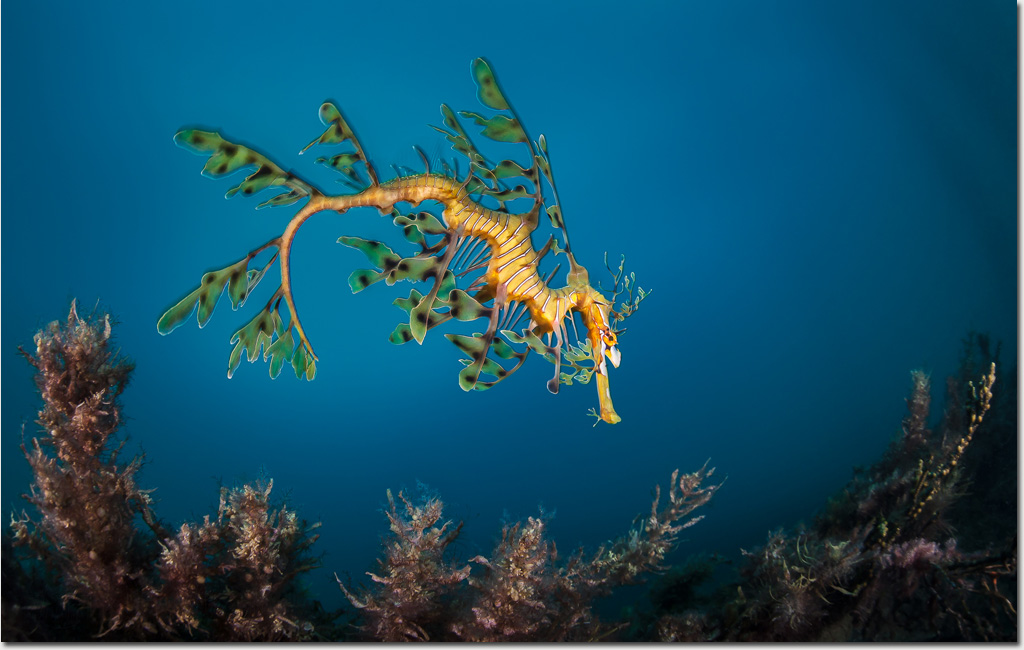
Suspended in the milky blue haze of a less than ideal Rapid Bay this leafy seadragon seems unperturbed with my presence.
When I arrived at Rapid Bay for this dive I looked out at the milky gypsum-dust laden water and nearly left for another location.
I am glad I decided to stay and dive here despite less than 2m visibility.
Who needs great visibility when you can get so close to these gorgeous creatures.
Photo: Robert Rath, 'Suspended', 1/80s f/8 ISO320 15mm
Tuesday, October 30. 2018
Dusk Delight
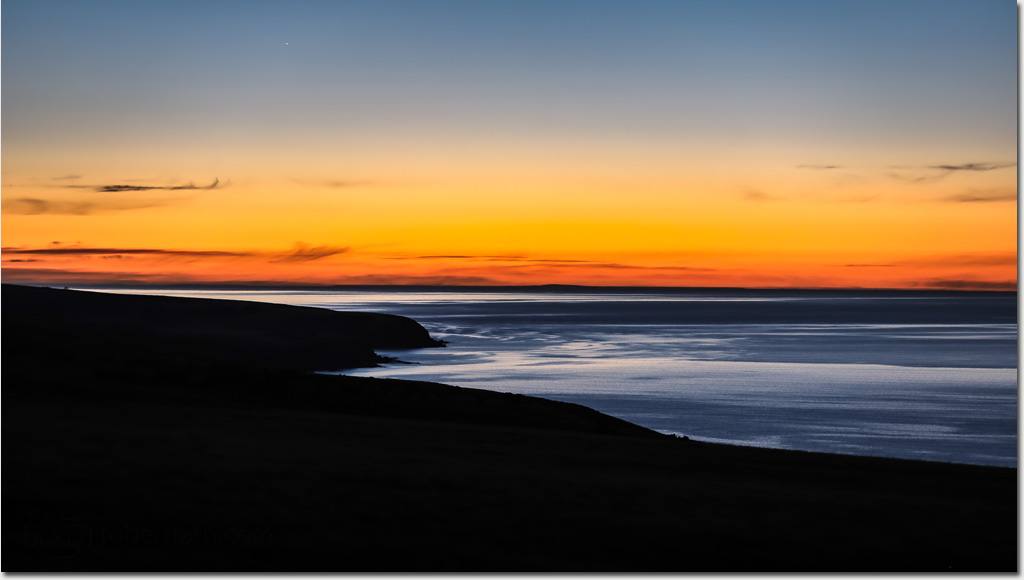
On my way home one recent afternoon diving the Fleurieu Peninsula, day turned to sunset and then to twilight as the first star of the evening became visible.
The simplicity, the colour and form of the scene looking back toward Myponga Beach was just too irresistible to pass up.
I got home a little later than planned that evening.
Photo: Robert Rath, 'Dusk Delight', 1/80s f/2.8 ISO800 125mm
Monday, October 29. 2018
Bedtime Lair
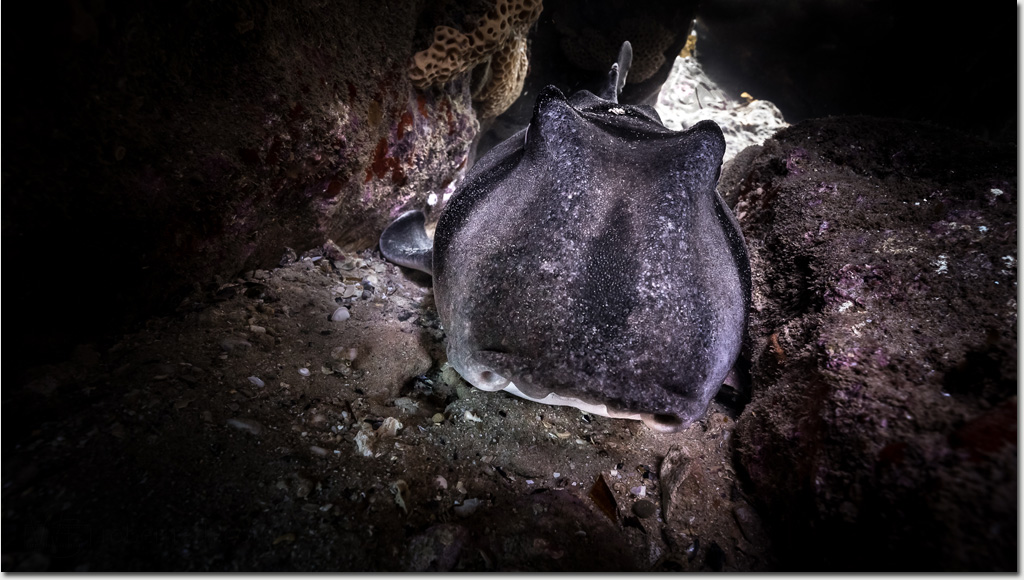
Here amid the myriad of small cave structures of Noarlunga Reef sleeps another of 'Porties' local resident species, a Port Jackson shark, Heterodontus portusjacksoni.
While doing some camera tests on the weekend I found myself peering into all the dark places I could find attempting to capture images without strobe lighting. Caves, nooks and ledges always seem to have interesting critters sheltering in safety. Often they are nocturnal creatures simply waiting for nightfall before venturing out.
I found three Port Jackson sharks last weekend, none of which was in a location conducive to really showing off this beautiful creature. At least just using natural light I did not have to worry about disturbing their daytime sleep.
Photo: Robert Rath, 'Bedtime Lair', 1/15s f/7.1 ISO1600 16mm
Sunday, October 28. 2018
Silver Drummer
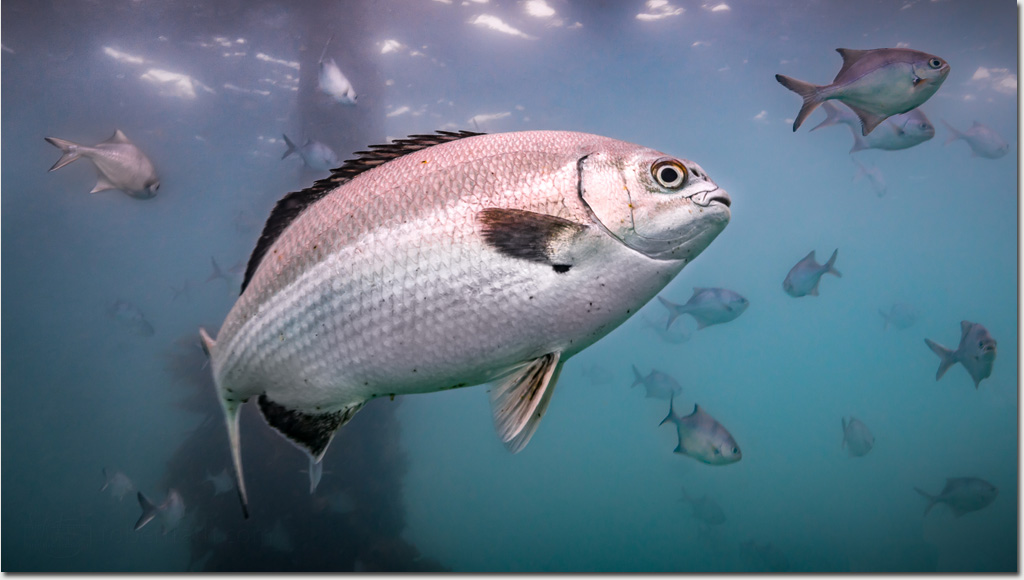
One of the most exciting fish species commonly found on Noarlunga Reef are silver drummer, Kyphosus sydneyanus. They are big, fast, often swim in large schools and are lots of fun to be in the water with.
During low tide when the inner reef is protected you might find a handful of them swimming among the sweep. During high tide when the waves are surging across the reef the silver drummer go crazy for morsels torn from the rocks.
This guy hanging with the sweep was a bit skittish and really did not want its image captured. After hovering mid-water for a while I finally got in a couple shots.
Photo: Robert Rath, 'Silver Drummer', 1/100s f/11 ISO320 35mm
Saturday, October 27. 2018
Dragon Fruit
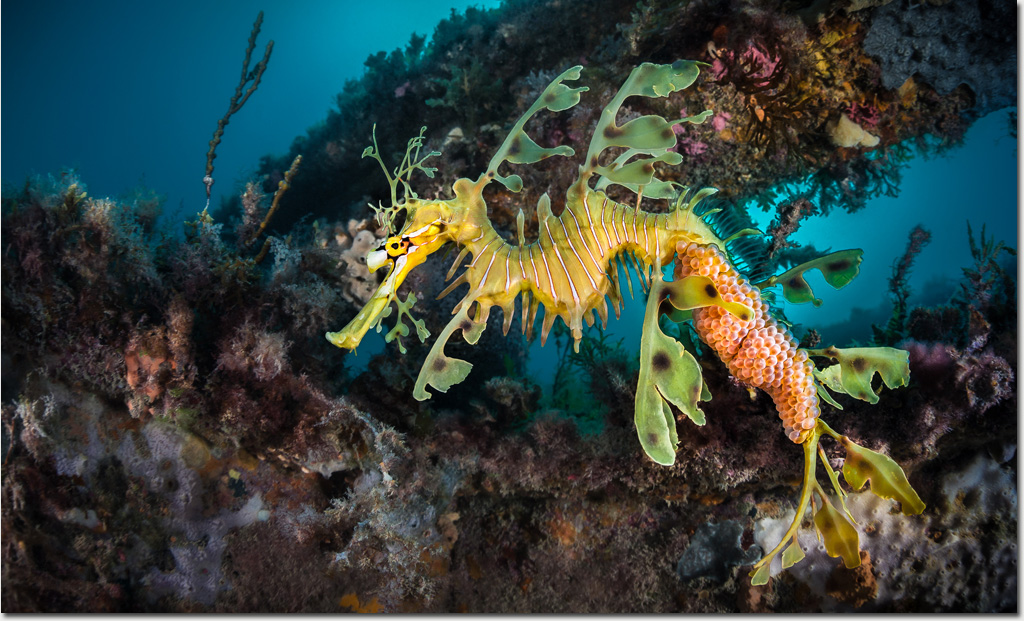
I never grow tired diving with these beautiful creatures and I still give a quiet yelp of delight when I find my first one on a dive.
Last weekend I was fortunate enough to see several of these gorgeous leafy seadragons during my dive at Rapid Bay.
This male is carrying a fresh batch of eggs which his female partner has left in his care while she goes off to do what ever females do when they don't have to nurture their young. He will protect them from predation while they develop but in a few weeks when they hatch they will emerge into a world where they will have to start fending for themselves and our male gets his leafy seadragon life back.
We are so lucky to live in a part of the world with such amazing critters as these.
Photo: Robert Rath, 'Dragon Fruit', 1/80s f/8 ISO320 15mm
Monday, October 22. 2018
Down To The Waterline
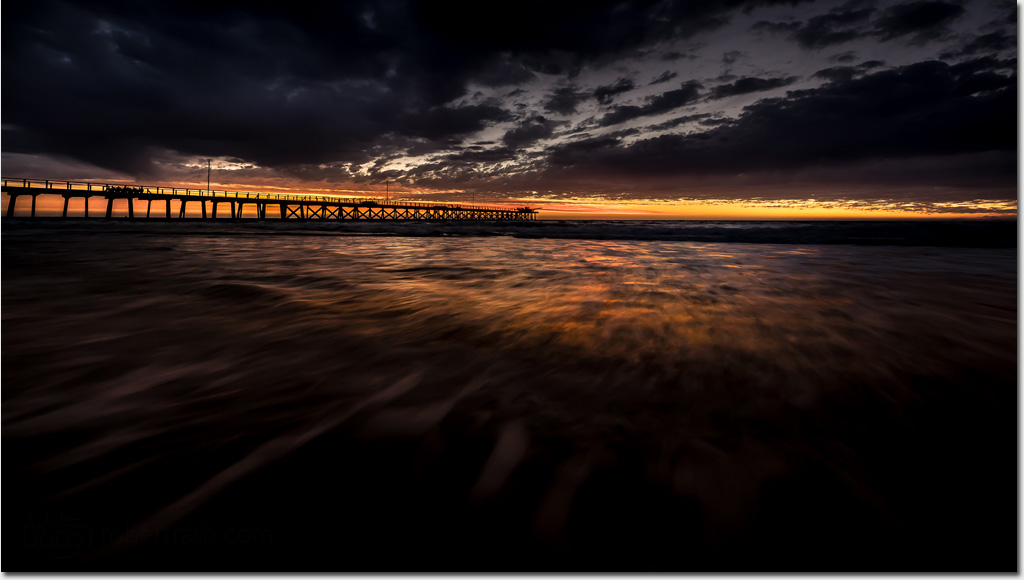
It was shaping up to be another beautiful Adelaide sunset.
I was on track to being down on the beach with the sun still shining above the horizon.
I didn't plan for my tripod falling to pieces and I didn't plan for the roadworks.
When I finally arrived the sun had long gone but I still when down to the waterline for this image.
Photo: Robert Rath, 'Down To The Waterline', 1/4s f/18 ISO1000 16mm
Saturday, October 20. 2018
Diving The 'T' Section
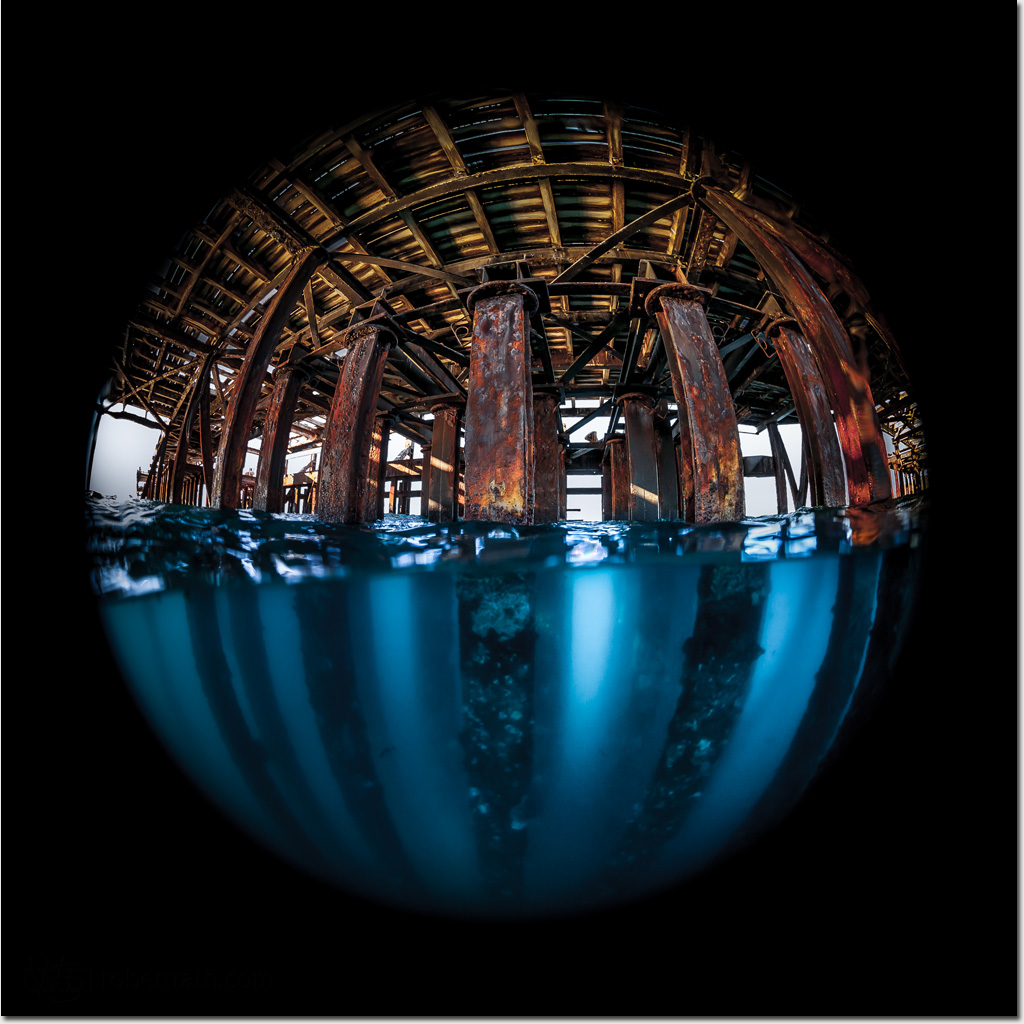
South Australian divers familiar with Rapid Bay Jetty will often talk about diving the 'T' Section.
This section of the old Rapid Bay Jetty has always been the jewel of marine life below the old jetty structure. Here the steel pylons grouped very close together provide cover for schools of reef fish while the complex bottom rubble supports a diverse benthic ecosystem.
I captured this under-over image today as the poor post weather fallout has left Rapid Bay a milky blue with only a few meters of visibility rendering the underwater scenery foggy and indistinct.
I'm looking forward to trying this image again when the conditions improve.
Photo: Robert Rath, 'Diving The 'T' Section, 1/250s f/4 ISO320 8mm
Thursday, October 18. 2018
Fiddle Chicks Part One, Emma Luker
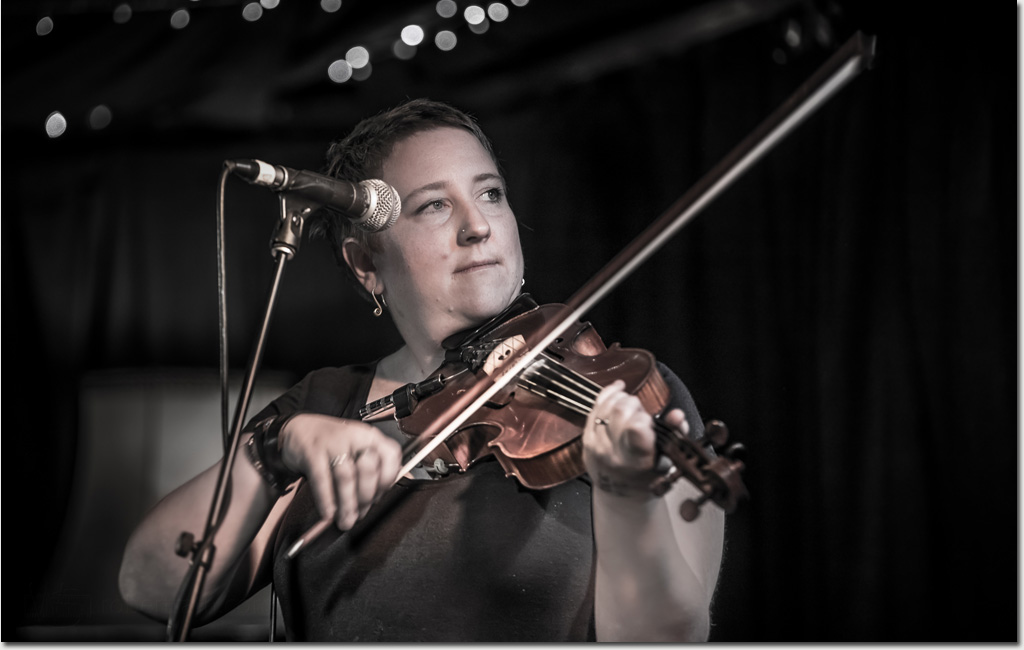
Friday night at the Wheatsheaf Hotel we experienced a double, double treat of local Adelaide musicians and folk music with the combined talents of the Fiddle Chicks, Emma Luker and Dee Trewartha and the trad music duo of Ray Smith and Kerryn Schofield.
Apologies for the labels guys!
More photos to follow but first of the rank is Emma Luker, fiddle chick extraordinaire!
Photo: Robert Rath, 'Fiddle Chicks Part One, Emma Luker', 1/80s f/2.8 ISO640 160mm
Wednesday, October 17. 2018
Bowl of Cowries
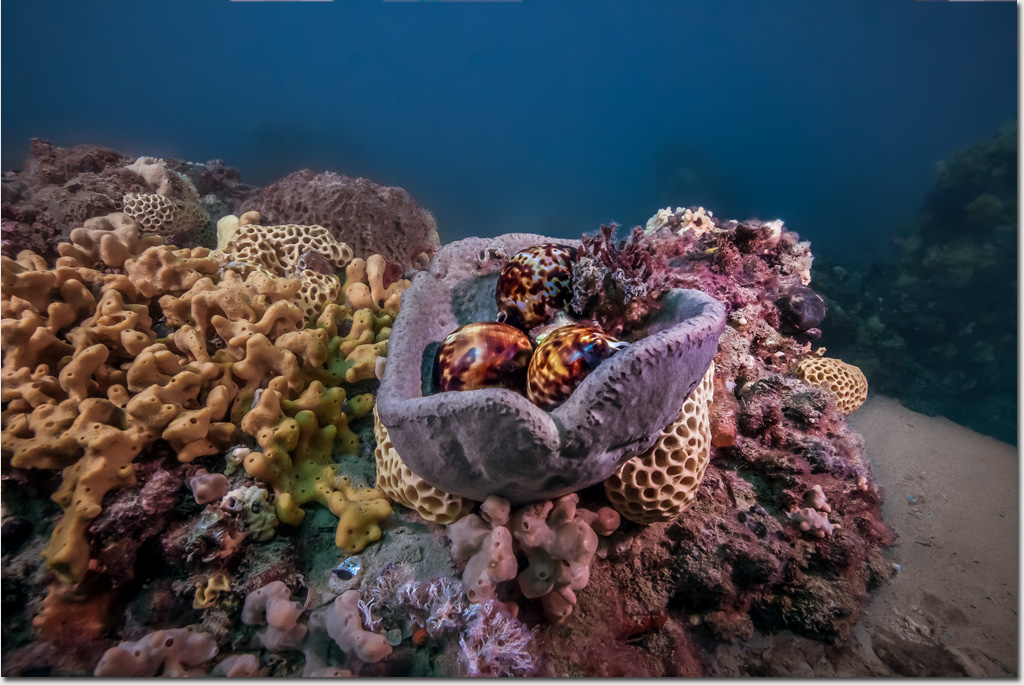
Bowl of Cowries
My dive buddy Andy spotted this extraordinary scene last weekend as we made our way north on the outside of Port Noarlunga Reef.
His odd gestures to me seemed to be asking, 'did I stage this", 'did some other divers before us stage this', or is there something special about this sponge that made three black cowries all come together like this? In nearly 30 year of diving I have only every seen black cowries on their solitary own.
Back cowries are one of our most beautiful mollusks with their glossy shells often protected by a thin velvety black mantle. Once they were prized by collectors but now the collecting of live shellfish is frowned upon and strongly discouraged. I once dived with with someone who horrified me by taking out his knife and defacing the beautiful shiny shell of any black cowrie he came upon. When I challenged his actions he said, 'I'm just making sure the collectors don't poach them'. I never did agree with him but I could see his point.
Again our local underrated Port Noarlunga dive site continues to delight and surprise with things I've never seen before in all my years of diving.
Photo: Robert Rath, 'Bowl of Cowries', 1/200s f/16 ISO640 16mm
Monday, October 15. 2018
Noarlunga Gorgonia
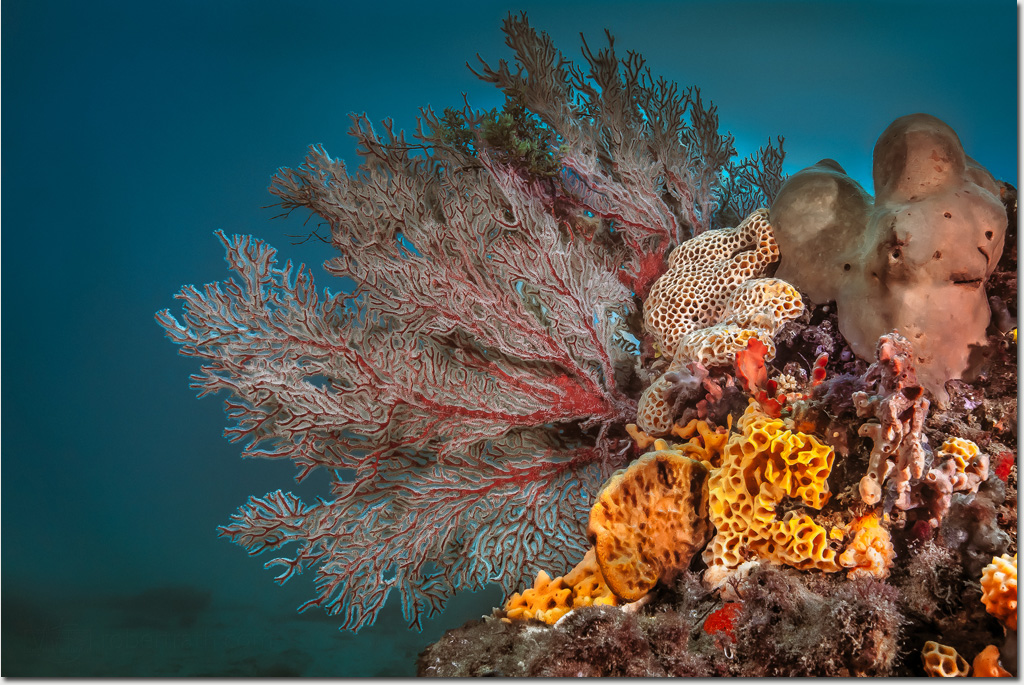
At a glance you could be excused for thinking this shot was taken on some exotic tropical reef. Certainly gorgonian corals often feature in deep tropical reef locations but they are just as at home here in our South Australian cold to temperate waters as in the tropics.
I first found gorgonian corals many years ago on one of Adelaide's most popular and underrated dive sites, Port Noarlunga Reef. Now, every time I dive here I experience a little bit of nostalgia and a little bit of regret for those divers who will only ever know this location as a training dive site.
Port Noarlunga Reef is popular because at least half of Adelaide's divers can get to it inside of 40mins, and underrated because most of them will never take the time to explore here properly. It takes about 10-15 dives to even get a feel for this interesting and highly accessible reef system. Add daylight/nighttime hours and seasons to that mix and this underrated location just keeps on delighting and surprising with its abundance and diversity of marine life.
This beautiful gorgonian coral off the south west corner of the reef in nearly 17m of water is just one of the reasons I keep coming back to dive here time after time.
Photo: Robert Rath, 'Noarlunga Gorgonian', 1/200s f/16 ISO640 16mm
Saturday, October 13. 2018
The Duck Knows
« previous page
(Page 18 of 77, totaling 2308 entries)
» next page

